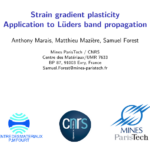Continuum Modelling and Simulation of Strain Ageing Phenomena in Metallic Alloys
Samuel Forest
Centre des Matériaux Mines ParisTech
France
17. April 2013, 17.00
WW8, Room 2.018-2, Dr.-Mack-Str. 77, Fürth
Strain-aging constitutive models are suitable to simulate the formation and propagation of Lüders bands in complex specimens and components [1]. The identification of the corresponding material parameters is difficult because the strain localization phenomena associated with the Lüders behavior must be taken into account. The spurious mesh dependence of standard finite element simulations of Lüders band propagation is illustrated in the present work and removed using a strain gradient plasticity model. Furthermore the gradient approach introduces a characteristic size corresponding to the finite dimension of the Lüders band front as observed from strain field measurements. The parameters are identified from the experimental measurement of the peak stress and plastic strain carried by the band for a C-Mn steel over a temperature range from 150°C to room temperature and for several strain rates [4]. The validity of the model is tested on 3D simulations of the Lüders band propagation in a strain gradient plasticity medium.
Ductile fracture of a C–Mn steel was also characterized by tensile tests performed in a large temperature range (from 20 to 350°C) on round notched and CT specimens. The experimental results revealed a sharp decrease in fracture strain and fracture toughness around 200°C. These temperatures correspond to the domain of dynamic strain ageing (DSA). The Portevin-Le Chatelier (PLC) effect, which is the most classical manifestation of DSA, was simulated for round notched and CT specimens with a mechanical constitutive model which includes the strain ageing effect [2,3,5]. 3D-Modeling was used to correctly capture the complex space-time correlation of strain localization, particularly in side-grooved CT specimens. The results were compared to classical elastic–plastic simulations. The local approach to fracture was then applied to predict the ductile fracture of round notched specimens using the Rice and Tracey criterion. In the DSA domain, the approach used in this study predicts a decrease of the fracture strain which is less than observed experimentally.
[1] S. Graff, S. Forest, J.L.S. Strudel, C. Prioul, P. Pilvin and J.L. Bechade, Strain localization phenomena associated with static and dynamic strain ageing in notched specimens: eperiments and finite element simulations, Materials Science and Engineering A, vol. 387-389, pp. 181-185, 2004.
[2] S. Graff, H. Dierke, S. Forest, H. Neuhäuser, J.L. Strudel, Finite element simulations of the Portevin-Le Chatelier effect in metal-matrix composites, Philosophical Magazine, vol. 88, pp. 3389-3414, 2008. doi:10.1080/14786430802108472
[3] M. Mazière, J. Besson, S. Forest, B. Tanguy, H. Chalons, F. Vogel, Numerical aspects in the finite element simulation of the Portevin-Le Chatelier effect , Computer Methods in Applied Mechanics and Engineering, vol. 199, pp. 734-754, 2010. doi:10.1016/j.cma.2009.11.004
[4] A. Marais, M. Mazière, S. Forest, A. Parrot and P. Le Delliou, Identification of a strain-aging model accounting for Lüders behavior in a C-Mn steel, Philosophical Magazine, vol. 28-30, pp. 3589-3617, 2012. doi:10.1080/14786435.2012.699687
[5] H.D. Wang, C. Berdin, M. Mazière, S. Forest, C. Prioul, A. Parrot, P. Le-Delliou, Experimental and numerical study of dynamic strain ageing and its relation to ductile fracture of a C-Mn steel , Materials Science and Engineering A, vol. 547, pp. 19-31, 2012. doi.org/10.1016/j.msea.2012.03.069


